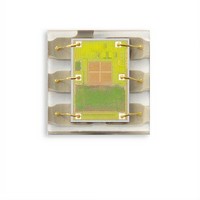TSL27711FN TAOS, TSL27711FN Datasheet - Page 11

TSL27711FN
Manufacturer Part Number
TSL27711FN
Description
Light to Digital Converters Light to Digital w/Proximity
Manufacturer
TAOS
Datasheet
1.TSL27713FN.pdf
(36 pages)
Specifications of TSL27711FN
Data Bus Width
16 bit
Peak Wavelength
640 nm, 850 nm
Maximum Operating Frequency
795 KHz
Operating Supply Voltage
2.4 V to 3.6 V
Operating Current
175 uA
Maximum Operating Temperature
+ 70 C
Minimum Operating Temperature
- 30 C
Interface Type
I2C
Maximum Fall Time
300 ns
Maximum Rise Time
300 ns
Mounting Style
SMD/SMT
Resolution
16 bit
Package / Case
DFN-6
Lead Free Status / RoHS Status
Lead free / RoHS Compliant
Available stocks
Company
Part Number
Manufacturer
Quantity
Price
Company:
Part Number:
TSL27711FN
Manufacturer:
TI
Quantity:
1 893
IR Factor and IAC
Sample Lux Calculation
The LUMENOLOGY r Company
The IR factor (IRF) is derived from the clear channel (CDATA), which is sensitive to both visible and infrared
light, and the IR channel (IRDATA), which is sensitive primarily to infrared light. The IR Factor is calculated based
on the ratio of the two photodiodes, which provides an optimized equation.
Because the two photodiodes have different spectral responses, the ratio of the channels will vary depending
on a particular light source’s spectral power distribution (SPD). Light sources such as an incandescent bulb or
sunlight have high amounts of infrared energy, while fluorescent bulbs have virtually no infrared energy.
Fluorescent lights have an IR Factor of approximately 80%; while incandescent light sources, with large
amounts IR, have IR Factors between 10% and 20%.
For RATIO = 0% to 30%
For RATIO = 30% to 38%
For RATIO = 38% to 45%
For RATIO = 45% to 54%
For RATIO > 54%
IRF is used in understanding the light attenuation under different circumstances. However, it is seldom
calculated in the actual implementation. IAC is typically used such that the RATIO not needed in this calculation.
For RATIO = 0% to 30%
For RATIO = 30% to 38%
For RATIO = 38% to 45%
For RATIO = 45% to 54%
For RATIO > 54%
Assume:
First, calculate IAC
Next, calculate CPL:
Finally, calculate lux:
Various techniques can be used to eliminate floating point calculations such as multiplying coefficients by 1000
or 1024. Care must be taken to keep the math in the integer size allocated and to keep the appropriate amount
of precision to avoid round-off errors.
RATIO = IRDATA / CDATA
For a ratio of 7.4%, use the first equation:
GA = 1, Gain = 16, Integration Time = 200 ms
Clear Data = 19476, IR Data = 1438 decimal
Ratio = IRDATA / CDATA = 1438 / 19476 = 7.4%
IAC = (1.000
IAC = (1.000
IAC = 16821
CPL = (Integration Time
CPL = 200
CPL = 61.5
lux = 16821 / 61.5
lux = 273
×
×
×
16 / (1
CDATA − 1.846
19476 − 1.846
×
r
52)
×
Gain) / GA
IRF = (1.000 − 1.846
IRF = (1.268 − 2.740
IRF = (0.749 − 1.374
IRF = (0.477 − 0.769
IRF = 0
IAC = (1.000
IAC = (1.268
IAC = (0.749
IAC = (0.477
IAC = 0
www.taosinc.com
×
×
1438)
IRDATA)
×
DF
×
×
×
×
CDATA − 1.846
CDATA − 2.740
CDATA − 1.374
CDATA − 0.769
×
×
×
×
RATIO)
RATIO)
RATIO)
RATIO)
LIGHT-TO-DIGITAL CONVERTER
r
×
×
×
×
IRDATA)
IRDATA)
IRDATA)
IRDATA)
with PROXIMITY SENSING
TAOS100A − FEBRUARY 2010
Copyright E 2010, TAOS Inc.
TSL2771
11





















